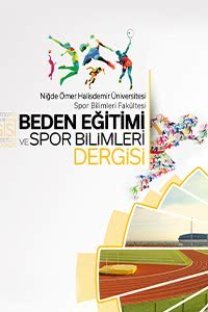COMPARİSON OF TURKISH NATIONAL KICKBOXERS ON MOTORIC PARAMETERS IN WEIGHT CATEGORIES AND PERFORMANCE LEVEL
Bu çalışmada elit Türk Kickboksörlerin sıkletlerine göre bazı motorik özelliklerinin ve sportif başarılarının karşılaştırılması amaçlanmıştır. Çalışmaya Avrupa Şampiyonası hazırlık kampında olan 37 denek katılmıştır ve katılımcılar üç gruba ayrılmışlardır: Grup A=Light-weight (60kg ve daha az, n=8); Grup B=Middle-weight (61 ve 74kg arası, n=16); ve Grup C=Heavy-weight (75 kg ve üstü, n=13). Denekler ayrıca başarılarına göre madalya kazananlar (Avrupa ve dünya şampiyonalarında ilk üçe girenler), (n=14; 22.07±3.17yıl, 175.35±8.30cm, 68.92±15.77kg) ve madalya kazanamayanlar (ilk üçe giremeyenler), (n=23; 23.04±4.80 years, 179.96±7.09cm, 75.01±14.78kg) şeklinde iki gruba ayrılmışlardır. Deneklere 20m sprint, esneklik, pençe kuvveti, bacak, sırt kuvveti, denge ve reaksiyon testleri uygulanmıştır. Sonuç olarak, mutlak ve relatif kuvvette ağırlık kategorilerine göre karşılaştırıldığında farklılık olduğu tespit edilmiştir. Reaksiyon, esneklik, denge ve sprint performanslarında istatistiksel olarak bir farklılık bulunamamıştır. Madalya kazanan deneklerin relatif kuvvetleri değerlendirildiğinde sağ el (0.71±0.11, 0.63±0.08 kg) ve sol el (0.71±0.11, 0.63±0.08 kg), sırt(1.98±0.52, 1.62±0.32 kg) ve bacak (1.86±0.39, 1.60±0.26 kg) kuvvetlerinde ve sprint değerlerinde(2.82±0.26, 3.18±0.47 sn) farklılık olduğu görülmüştür.
This study examined some basic motoric features of elite Turkish kickboxers according to their weight categories (light, middle and heavy-weight) and sporting success. The study included 37 kickboxers in the camping period prior to the European Kickboxing Championship, and the participants were divided into three categories: Group A=Light- weight (60 kg and less, n=8); Group B=Middle-weight (between 61 and 74 kg, n=16); and Group C=Heavy-weight (75 kg and more, n=13). Participants were also divided into two groups: medalists (n=14; 22.07±3.17 years, 175.35±8.30cm, 68.92±15.77kg) and non-medalists athletes (n=23; 23.04±4.80 years, 179.96±7.09cm, 75.01±14.78kg). The participants completed a 20-meter sprint and tests of flexibility, handgrip strength, back and leg strength, balance and reaction. In conclusion, a significant difference was observed only in the parameters of absolute and relative strength between the weight categories, whereas no significant difference was found in the parameters of reaction, flexibility, balance and sprint. In addition, the basic motoric features of medalist athletes, which were different from others, were found to be relative strengths relative right hand grip strength (0.71±0.11, 0.63±0.08 kg), relative left hand grip strength (0.71±0.11, 0.63±0.08 kg), relative leg strength (1.86±0.39, 1.60±0.26 kg), relative back strength (1.98±0.52, 1.62±0.32 kg) and speed (2.82±0.26, 3.18±0.47 sec) p<0.05.
___
1. Almansba R, Sterkowicz S, Belkacem R, Sterkowicz- Przybycien K, Mahdad D. Anthropometrical and physiological profiles of Algerian Olympic judoists. Archives of Budo, 6(4):185-193,2010.2. Bal BS, Yadav S, Sinha A. Comparison of the relative strength among the different weight categories of power lifters. Journal of Physical Education & Sports, 27(2):126- 130,2010.
3. Buse GJ. Kickboxing. In: Kordi R, Maffuli N, Wroble RR, Wallace WA, editors. Combat sports medicine. London: Springer; 2009.
4. CarcassiAM,Calò CM. Anthropometric features and body composition of athletes practising bodybuilding and kickboxing.Antropo, 9:71-76,2005.
5. Castro MJ, McCann DJ, Shaffrath JD, Adams WC. Peak torque per unit cross-sectional area differs between strength-trained and untrained young adults. Med Sci Sport Exer, 27:397- 9,1995.
6. Devonport T. Perceptions of the contribution of psychology to success in elite kickboxing. J Sports Sci Med, 99-107,2006.
7. Fox EL. Sports physiology. Saunders College Pub: Philadelphia;1984.
8. Franchini E, Del Vecchio FB, Matsushigue KA, Artioli GG. Physiological profiles of elite judo athletes.Sports Med, 41(2):147-66,2011.
9. Glass SC,ReegEA, Bierma JL. Caloric cost of martial arts training in novice participants. J ExercPhys, 5(4):29- 34,2002.
10. Heller J, Peric T, Dlouha R, Kohlikova E, Melichna J, Novakove H.Physiological profiles of male and female taekwondo (ITF) black belts. J Sport Sci, 16:243- 249,1998.
11. Jung CM. The world of taekwondo research. Korea: Seoul; 1988.
12. Kanyevsky V. The dependence between the weightlifter's absolute and relative strength on weight class. The Russian weightlifting library. Sportivny, Press.Russian; 1993.
13. Ljubisavljević M, Blažević S, Amanović D. Motor Differences of young kıck-boxer categories based on result successfulness. Sport Science, 2:74-78, 2011.
14. Machado SM, Osorio RAL, Silva NS, Magini M. Biomechanical analysis of the muscular power of martial arts athletes. Med BiolEng, 48:573-577,2010.
15. Madden M. Perceived vulnerability and control of martial arts and physical fitness students. Percep Mot Skills, 80:899-910.1995.
16. Marković G, Duraković MM, Trninić S. Fitness profile of elite Croatian female taekwondo athletes. Collegium Antropol, 29 (1): 9399, 2005.
17. Miguel AR, Anita RMB, Walter RF. Health related physical fitness characteristics of elite Puerto Rican athletes. J Strength Cond Res, 12(3):199-203,1998.
18. O Donovan O, Cheung J, Catley M, McGregor AH, Strutton PH. An investigation of leg and trunk strength and reaction times of hard-style martial arts. Journal of Sports Science and Medicine, CSSI:5-12,2006.
19. Petrov R. Perfertionnenement de la maitrisetechnico- tactigue de lutteurmedicinaifizkultura, Sofia; 1978.
20. Roschel H, Batista M, Monteiro R, et all. Association between neuromuscular tests and kumite performance on the Brazilian Karate National Team. Journal of Sports Science and Medicine, 8(CSSI3):20-24, 2009.
21. Sertic H, Seged I, Milanovic D. Anthropological and fitness status of Croatian judoists. Archives of Budo, 2:24-27,2006.
22. SuzanaMA, Pieter W.Motor ability profile of junior and senior taekwondo club athletes.Braz J Bio, 3(4):325- 331,2009.
23. Winter EM, Maughan RJ. Strength and cross-sectional area of the quadriceps in men and women. J Physiol, 438-175,1991.
24. Yoon J. Physiological profiles of elite senior wrestlers. Sports Med, 32(4):225-33,2002.
25. Zabucovec R, Tiidus PM. Physiological and anthropometric profile of elite kick-boxers. J Strength Cond Res, 9(4):240242,1995.
- ISSN: 1307-6477
- Yayın Aralığı: Yılda 3 Sayı
- Başlangıç: 2007
- Yayıncı: Niğde Üniversitesi Beden Eğitimi ve Spor Yüksek Okulu
Sayıdaki Diğer Makaleler
HALİL İBRAHİM CEYLAN, ÖZCAN SAYGIN, MEVLÜT YILDIZ
HAKAN ÜNAL, DUYGU YILDIRIM, GÖNÜL BABAYİĞİT İREZ
COMPARISONS OF GAME PARAMETERS FOR ROMANIAN WOMEN'S BASKETBALL LEAGUE AND LONDON 2012 OLYMPIC GAMES1
ENDER ŞENEL, Cansen YENIYOL, Özge KÖLE, İlhan ADİLOĞULLARI
EXAMINATION OF PERSONALITY CHARACTERISTICS OF STUDENTS AT HIGH SCHOOLS GIVING SPORTS EDUCATION
SERKAN KURTİPEK, Tekin ÇOLAKOĞLU
YAPRAK KALEMOĞLU VAROL, M. Kayıhan ERBAŞ, HÜSEYİN ÜNLÜ
ASSESSMENT OF BURNOUT LEVELS OF SPORT CLUB ADMINISTRATORS
Mehtap AKILLI SAATOĞLU, ELİF KARAGÜN
HAKKI ULUCAN, İLHAN ADİLOĞULLARI, Deniz ÜNVER
COMPARISONS OF GAME PARAMETERS FOR ROMANIAN WOMEN'S BASKETBALL LEAGUE AND LONDON 2012 OLYMPIC GAMES1
